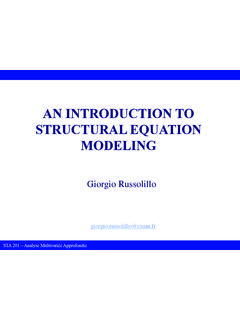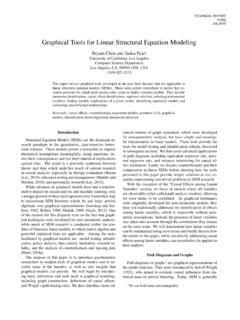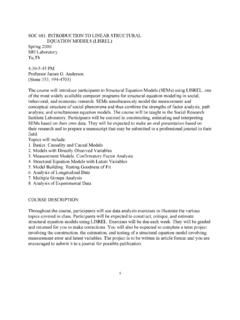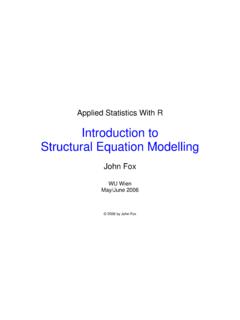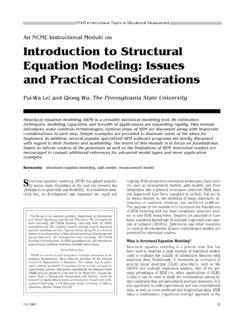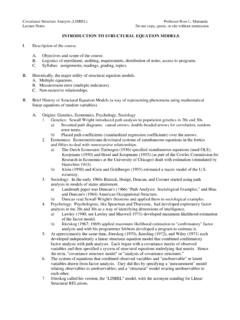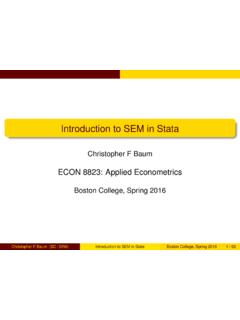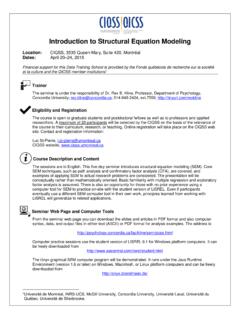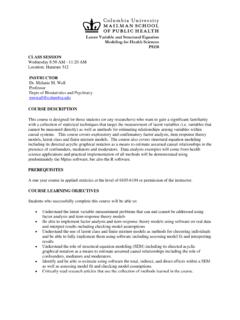Transcription of Chapter 17 STRUCTURAL EQUATION MODELING
1 1 Chapter 17 STRUCTURAL EQUATION MODELING1 Victoria Savalei, University of California, Los Angeles Peter M. Bentler, University of California, Los Angeles introduction STRUCTURAL EQUATION MODELING (SEM) is a tool for analyzing multivariate data that has been long known in marketing to be especially appropriate for theory testing ( , Bagozzi, 1980). STRUCTURAL EQUATION models go beyond ordinary regression models to incorporate multiple independent and dependent variables as well as hypothetical latent constructs that clusters of observed variables might represent. They also provide a way to test the specified set of relationships among observed and latent variables as a whole, and allow theory testing even when experiments are not possible.
2 As a result, these methods have become ubiquitous in all the social and behavioral sciences ( , MacCallum & Austin, 2000). A review of use of SEM in marketing research is provided by Baumgartner and Homburg (1996); see also Steenkamp and Baumgartner (2000). In this Chapter , we introduce the basic ideas of SEM using a dataset collected to test the theory of planned behavior (TPB; Ajzen, 1991). TPB is an extension of the earlier theory of reasoned action (Fishbein & Ajzen, 1975), and both attempt to address the often observed discrepancy between attitude and behavior. Theory of reasoned action proposed that attitudes influence behavior indirectly by influencing a person s intentions to act, and that subjective norms (for instance, what important others think is the appropriate behavior in a given situation) influence intentions as well. Theory of planned behavior expands theory of reasoned action by adding a third predictor of intentions: perceived behavioral control (PBC; see Figure for a conceptual diagram).
3 TPB is most applicable when 2 deliberative or planned behavior is of interest, and has been successfully applied to a wide variety of behaviors. Extensions of theory of planned behavior to include other predictive variables have also been proposed in marketing context ( , Bagozzi & Warshaw, 1990; Perugini & Bagozzi, 2001). In our example, we use the theory to understand predictors of dieting behavior. The data were collected from a sample of 108 college students who had the goal of reducing or maintaining their current body Participants attitudes towards dieting were examined using 11 semantic differential items, of which 6 were designed to tap the more cognitive aspect of the attitude ( , useless-useful) and 5 were designed to tap the more affective aspect of the attitude ( , unenjoyable-enjoyable).
4 Subjective norms were measured by asking participants to list three most important persons to them and indicate how much each would approve or disapprove of their dieting. Perceived behavioral control (PBC) was measured by asking participants how much control they had over sticking to a diet, whether dieting was difficult or easy, and whether sticking to a diet for the next four weeks would be likely or unlikely. Intentions were measured by asking participants whether they plan to stick to a diet, whether they intend to stick to a diet, and finally whether they will expend effort to stick to a diet. A self-report measure of behavior was obtained a few weeks later by recontacting participants. Further details regarding the measures can be found in Perugini and Bagozzi (2001), who also test a more complex model. The conceptual model for these data is illustrated in Figure Here, each construct of interest is represented by a circle, and the influence of one variable on another is represented by an arrow.
5 Assuming the relationships between the variables are linear, we can convert the diagram into two regression equations : 123 IIntAttNormsPBC =+ + + 4 BBehInt =+. 3 There are two equations because in the diagram, there are exactly two variables that have one-way arrows aiming at them. Each coefficient is a one-way arrow in the diagram. The residual s are not shown. [FIGURE ABOUT HERE] Thus, one way to estimate the coefficients 1 through 4 is by running two separate regressions (see Chapter 13, Regression Models). There are several disadvantages to this method, however. First, each construct appearing in the EQUATION above, with the exception of behavior, is measured by several different items in the dataset.
6 To avoid fitting an extremely large number of regressions, we will have to combine our items to create scales, thus losing any information about possible differential performance of some measures of a given construct over others. Further, the newly created scales might or might not be reliable, and while we can assess their reliability (using Cronbach s , for example), this information does not affect the computation of the regression coefficients, and we would interpret our final regression equations as if they represented a good estimate of the relationships of interest. Finally, fitting separate regression equations to different parts of our model does not provide any way to assess the overall model fit. In other words, in addition to estimating what the values of the paths in our diagram would be if the theory were true, we would like to test if the theory as presented in this diagram actually is true.
7 Some limited model testing occurs in a regression setting also; for example, when we look at the scatter plot of our data to see whether it follows a curvilinear pattern, we informally evaluate whether the assumed linear regression model actually holds, and this evaluation is quite independent of the obtained estimates for slope and intercept. Path Analysis In contrast to the separate regressions approach, a statistical technique known as path analysis (or simultaneous equations ) can be used to obtain both the path values (estimated ) for the model and 4 a test of the overall model fit. This technique is actually a special case of SEM, one that only involves observed variables, so we will discuss it in some detail.
8 The goal of path analysis, and more generally of SEM, is to see how well our proposed model, which is a set of specified causal and noncausal relationships among variables, accounts for the observed relationships among these variables. The observed relationships are usually the covariances, summarized in the sample covariance matrix, which we will call S. If we could measure everyone in the population, we would obtain the population covariance matrix, . Of course we cannot do that, but S serves as a good estimate of , and this estimate gets better as the sample grows larger. The most important idea in SEM is that under the proposed model, the population covariance matrix has a certain structure; that is, some of its elements are functions of other elements or other parameters in the model (such as regression coefficients). If we estimate these more basic parameters from the data, we can compute an estimate of the population covariance matrix (call it ) that is based on the assumed model as well as the data.
9 When the model is true, S and are estimates of the same thing, namely . When the model is false, they are not. Thus, we can evaluate model fit by comparing S and as estimated from our sample. Before we can illustrate this idea on our example, we need a more detailed diagram for our model. In Figure , we follow the path analysis convention of using boxes to represent observed variables (circles are reserved for latent constructs), one-way arrows to represent regression coefficients, and curved double-headed arrows to represent covariances among independent variables. Here, we chose to allow the independent variables on the left the variables without any one-way arrows aiming at them -- to correlate, which is a common assumption. However, a model without such correlations or only with some of them present can just as easily be specified and tested. Random errors from the regression equations we stated earlier are now also part of the diagram.
10 For example, the EQUATION 4 BBehInt =+ states that behavior is influenced both by intentions and by random error (which can 5 also be thought of as all other unspecified influences). In the diagram, this EQUATION is represented by two arrows pointing to behavior, one from intentions and one seemingly from nowhere. Technically, the random errors themselves should be represented as variables in the diagram, but it is common to omit them. Paths that are not in the diagram are especially informative of the model being tested. For example, the random error from predicting behavior is uncorrelated with any of the other independent variables, because there are no curved arrows starting from it.
